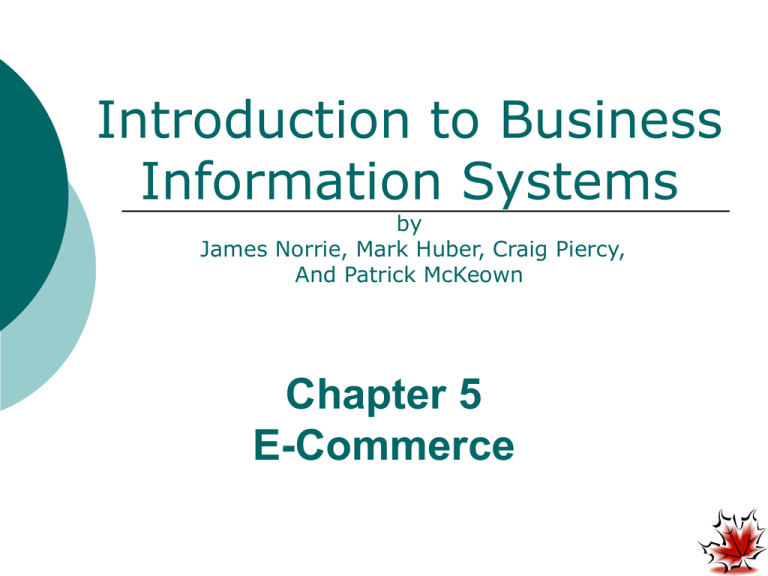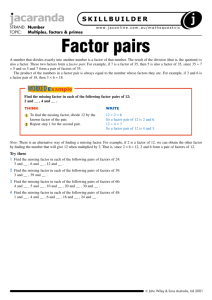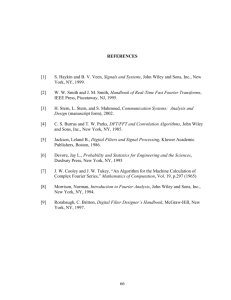
Introduction to Business
Information Systems
by
James Norrie, Mark Huber, Craig Piercy,
And Patrick McKeown
Chapter 5
E-Commerce
What We Will Cover
• E-Commerce Defined
• The E-Commerce Advantage
• Benefits and Limitations of E-Commerce
• E-Commerce Between Organizations
Copyright 2010 John Wiley & Sons Canada Ltd.
Student Return on Investment
Your investment of time and effort in this
course will result in your being able to
answer these questions:
What is e-commerce and how is it a part of
today’s economy?
How does e-commerce create value and
make a difference to businesses and
consumers?
How can organizations use e-commerce to
enhance the delivery of products and
services, manage trade with business
partners, and improve their supply chain
efficiency?
Copyright 2010 John Wiley & Sons Canada Ltd.
E-Commerce Defined
E-commerce is the use of information
systems, technologies, and computer
networks by individuals and
organizations to carry out transactions in
order to create or support the creation of
business value
Copyright 2010 John Wiley & Sons Canada Ltd.
E-Commerce Defined
E-commerce includes all types of
computer networks, transactions, and
business relationships including:
• electronic funds transfers
• EDI over private networks
• retail sales and wholesale exchanges
over public networks like the Internet
o Most people think of e-commerce as
electronic shopping over the Internet or
B2C e-commerce
Copyright 2010 John Wiley & Sons Canada Ltd.
Types of E-Commerce Transactions
and Example Websites
Description
Example Websites
B2C
On-line equivalent of www.chapters.indigo.ca
retail store as well as www.telus.ca
other services
www.amazon.ca
B2B
Electronic exchanges
between companies
B2G
On-line sales to
www.ppitpb.go.on.ca
government agencies (Ontario government)
C2G
Electronic payment
of taxes
www.netfile.gc.ca
C2C
Use of online
auctions
www.ebay.ca
auctions.yahoo.ca
www.manheim.com
www.boeing.com
Copyright 2010 John Wiley & Sons Canada Ltd.
E-Commerce and Products:
Physical and Digital
Products can be divided into two primary
categories: physical and electronic
Physical products: anything that requires
an actual shipment of a package to the
buyer
Digital products: can be received directly
over the Internet or other computer
network
E-commerce companies must have backoffice elements to handle order fulfillment
and returns for physical goods
Companies experienced in order fulfillment
and returns have tended to be successful in
e-commerce
Copyright 2010 John Wiley & Sons Canada Ltd.
Types of E-Commerce Transactions
and Associated Goods
Example Physical
Goods
Example Electronic
Goods
B2C CD, DVD
iTunes, ring tones
B2B Office furniture
Virus protection software,
databases
B2G Technical manuals,
Document conversion from
regulations, and
hardcopy to XML/Web-based
other printed material documents
C2G Printed and mailed
income tax return or
licence application
Electronically filed income
tax return or licence
application
C2C Elvis PezTM, comic
books
Shareware programs, selfpublished e-books
Copyright 2010 John Wiley & Sons Canada Ltd.
Purchase of Physical Goods
Copyright 2010 John Wiley & Sons Canada Ltd.
Purchase of Electronic Goods
Copyright 2010 John Wiley & Sons Canada Ltd.
E-Commerce Business Models
1
A business model defines how a
company will meet the needs of its
customers while making a profit
An e-commerce business model combines
a specific type of website with a
successful revenue model that produces
profits for the website owner
The next three slides list and give
examples of e-commerce business
models1
Adapted from Micheal Rappa, http://digitalenterprise.org/models/models.html
Copyright 2010 John Wiley & Sons Canada Ltd.
E-Commerce Business Models
Business
Model
Description
Examples
Brokerage
Brokers bring buyers
and sellers together for
a fee
eBay, Priceline,
PayPal
Advertising An extension of the
traditional media
broadcasting model
where ads appear on
websites
Yahoo!, Netscape,
CNN.com, Google
Merchant
Amazon.ca,
CanadianTire.ca,
Walmart.ca, iTunes
Sells products, both
physical and electronic,
to consumers
Copyright 2010 John Wiley & Sons Canada Ltd.
E-Commerce Business Models
Business
Model
Description
Examples
Manufacturer Make and sell products
Direct
directly to consumer
Dell, IBM,
Microsoft,
McAfee
Affiliate
Affiliate websites are
paid a fee when
purchases come
through them
Amazon.ca fees
to affiliate
websites
Community
Based on user loyalty
because of high
investment of time and
emotion
MySpace
Evite
Copyright 2010 John Wiley & Sons Canada Ltd.
E-commerce Business Models
Business
Model
Description
Examples
Subscription Users are charged fees
to subscribe to service
or information source
Classmates,
globeandmail.com
Infomediary Provides data on
consumers and
consumption habits
DoubleClick,
NetRatings,
Edmunds
Co-operative Enables competitors to
co-operate on a
website
AutoTrader.com,
VRBO.com,
craigslist
Copyright 2010 John Wiley & Sons Canada Ltd.
E-Commerce Website Purpose
The purpose of an e-commerce website is
to bring in customers, or at least visitors
No matter how good the business model is,
it will not generate a profit if not associated
with an appealing website
There are eight commonly accepted types
of websites: portal, search engine, browse
or search and buy, sales support,
information service, auction, travel, and
special interest or services
A number of these match up with multiple
business models
Copyright 2010 John Wiley & Sons Canada Ltd.
Websites Classified by Purpose
Purpose
Example
Business
Model
Portal
A gateway to many Netscape,
other websites
Yahoo! MSN
Search
Engine
Finds websites that Google, Yahoo! Advertising,
contain a word or
MSN, DogPile
Affiliate,
phrase
Infomediary
Browse
or
Search
and Buy
Sell goods and
services
Sales
Support
Provide information Microsoft,
on a product before BMW, McAfee,
or after the sale
Telus
Dell,
LandsEnd,
iTunes
Copyright 2010 John Wiley & Sons Canada Ltd.
Advertising,
Affiliate
Merchant,
Infomediary,
Manufacturer
Direct,
Co-operative
Community,
Infomediary
Websites Classified By Purpose
Purpose
Example
Business
Model
Information Provide news,
Service
information,
commentary, etc.
National
Post, TSN,
Economist
Subscription,
Community,
Affiliate
Auction
Facilitate sales
between third parties
eBay,
PayPal
Brokerage
Travel
Sells travel tickets
and tours
Delta,
Travelocity,
Orbitz,
itravel2000
Merchant,
Brokerage,
Cooperatitive
Special
Interest or
Services
Provide information,
product sales and
support, and contacts
between visitors
Lavalife,
Microsoft
support
groups,
Community,
Merchant,
Affiliate,
Infomediary,
Advertising
Copyright 2010 John Wiley & Sons Canada Ltd.
The E-Commerce Advantage
The use of computer networks to carry out
transactions is creating a tangible “ecommerce advantage” in our economy,
especially with regard to
technology
competition
strategy
Over 1.5 billion potential customers in the
marketplace due to increasing Internet access
Universal standards make it work the same
way no matter where in the world you are
Copyright 2010 John Wiley & Sons Canada Ltd.
Impact of E-Commerce
Technologies on Business
Copyright 2010 John Wiley & Sons Canada Ltd.
Information Clutter
The expansion of global e-commerce has
produced global competition with sellers
being able to reach any potential buyer
worldwide
Technology has increased information
density—the quality and quantity of
information about products and services
Customers can obtain product guides,
reviews, and prices from a number of
websites due to online advertising and
search engine optimization
Copyright 2010 John Wiley & Sons Canada Ltd.
Mass Customization and
Personalization
One response to information density is to
create business value based on a
customization approach to e-commerce
Two approaches to customization are mass
customization and personalization
Mass customization is the ability to create
custom products or services on demand,
(e.g., Dell Computer)
Personalization is a personalized
marketing message for each potential
customer based on searching, browsing, or
buying habits (e.g., Amazon.ca)
Copyright 2010 John Wiley & Sons Canada Ltd.
E-Commerce Competitive Difference
E-commerce is having a dramatic effect on
competition between organizations in a
number of ways:
Reducing barriers to entry
Preventing any company from “owning” the
market
Enhanced collaboration/alliances
Multiplying market niches
Changing marketplace drivers (forces that
make things happen in the market, e.g.,
consumer preferences, number of suppliers
a business can choose from, etc.)
Copyright 2010 John Wiley & Sons Canada Ltd.
E-Commerce and Business
Strategy
Technology advances have changed
business strategy
A strategy is a broad-based formula for
how a business is going to compete, what
its goals should be, and what plans and
policies will be needed to carry out those
goals1
1 Michael
Porter “What is Strategy”, Harvard Business Review, November 1996, pp. 69–84.
Copyright 2010 John Wiley & Sons Canada Ltd.
E-Commerce and Business Strategy
An e-commerce strategy is a general
term for how a business is going to use
web-based networks and information
systems to compete in a global marketplace
Building an e-commerce strategy requires
two views of an organization’s strategy:
1. what it wants to do (conceptual)
2. how it will do it (technology strategy)
One strategy being used by many
companies is customer relationship
management (CRM), which enables them to
create one-to-one marketing experiences
for their customers
Copyright 2010 John Wiley & Sons Canada Ltd.
E-Commerce and Business Strategy
Other e-commerce strategies include:
virtual showrooms
increased channel choices
wider component choice
use of mobile technology
Mobile commerce is the use of laptops,
mobile phones, and PDAs to connect to the
Internet and Web to conduct many of the
activities associated with e-commerce
Copyright 2010 John Wiley & Sons Canada Ltd.
Benefits for Consumers
Lower prices
Shopping 24/7
Greater searchability for products
Shorter Delivery times
More sharing of information with
other consumers
Improved customer service
Copyright 2010 John Wiley & Sons Canada Ltd.
Limitations for Consumers
Delay in receiving goods
Slow download speeds
Security and privacy concerns
Inability to touch, feel, smell tryout,
or try on products prior to
purchasing
Unavailability of micropayments
Copyright 2010 John Wiley & Sons Canada Ltd.
Benefits for Business
Expansion of marketplace to global
proportions
Cheaper electronic transaction
Greater customer loyalty
Expansion of niche marketing
opportunities
Direct communication with
customers via websites
Copyright 2010 John Wiley & Sons Canada Ltd.
Limitations for Businesses
Increased competition
Ease of comparison between
competing products drives prices
down
Customers want specific choices
and will not accept substitutes
Customers control flow of
information instead of companies
Copyright 2010 John Wiley & Sons Canada Ltd.
E-Commerce between
Organizations
Doing business with other organizations
(B2B) is by far larger than with consumers
(B2C)
It is also quite different in terms of the scope
of the purchases and the complexity
involved in them—especially in the decisionmaking process required to make a purchase
For example, while you buy one PC, a
company may buy thousands
Interorganizational systems (IOS) are the
information systems that handle the
information flow between trading partners
Copyright 2010 John Wiley & Sons Canada Ltd.
B2B Transactions and Business Models
B2B transactions can be divided into two
types: spot buying and strategic sourcing
In spot buying purchases are made at market
prices from an unknown seller
Companies often use spot buying to
purchase commodities (gasoline, paper,
cleaning suppliers, etc.)
In strategic sourcing prices are set through
negotiation in a long-term relationship with a
company known to the buyer
A company’s large-scale computer
purchases often result from strategic
sourcing
Copyright 2010 John Wiley & Sons Canada Ltd.
B2B Transactions and Business Models
In the one-to-one business model, two
companies form a trading relationship with
neither company dominating the relationship
In the company-centric business model, a
company is either a seller to many companies
(one-to-many) or a buyer from many
companies (many-to-one)
The single company dominates the market and
controls the information systems that support
the transactions. Electronic data interchange
(EDI) or an extranet is often used to link
trading partners
E-procurement is often the name for B2B
e-commerce in the many-to-one business model
Copyright 2010 John Wiley & Sons Canada Ltd.
Company-Centric Business Model
Copyright 2010 John Wiley & Sons Canada Ltd.
Exchange Model
In the exchange business model, many
companies use an exchange to buy and
sell from each other through spot-buying
transactions
Copyright 2010 John Wiley & Sons Canada Ltd.
Using B2B E-Commerce to
Improve Supply Chain Efficiency
A supply chain is a network of facilities and
distribution options that performs the
functions of procurement of materials,
transformation of these materials into
intermediate and finished products, and the
distribution of these finished products to
customers1
Procurement is a big part of the supply chain,
and using e-commerce for procurement has
resulted in cost savings
To see why, we first need to understand the
traditional procurement process
“An Introduction to Supply Chain Management”, Ram Ganeshan Terry P. Harrison,
http://lcm.csa.iisc.ernet.in/scm/supply_chain_intro.html
1
Copyright 2010 John Wiley & Sons Canada Ltd.
Traditional Procurement Process
In the traditional procurement process, there are
five steps involving three elements—purchase
order, invoice, and receipt of goods:
1. Purchase order (PO) to vendor
2. Goods to buyer along with bill of lading (BOL)
3. Upon receipt of goods and BOL, signed copy
of BOL returned to vendor and receipt of
goods is filed
4. Vendor sends invoice to buyer
5. Buyer’s accounting department compares PO
to receipt of goods and invoice. If there is a
match, buyer pays the vendor
Copyright 2010 John Wiley & Sons Canada Ltd.
Traditional Procurement Process
Copyright 2010 John Wiley & Sons Canada Ltd.
Interorganizational Systems (IOS)
An interorganizational system (IOS)
is a networked information system used
by two or more separate organizations to
perform a joint business function1
The two most common forms of IOS are
EDI and extranets
1 J.
I. Cash Jr., F. W. McFarlan, J. L. McKenney, and L. M. Applegate. 1994.
Corporate Information Systems Management. 4th ed. Homewood, IL: Irwin, p. 339.
Copyright 2010 John Wiley & Sons Canada Ltd.
Electronic Data Interchange (EDI)
EDI uses private networks to allow the
exchange of structured information
between two computer applications with a
minimum of human involvement
Even though often overshadowed by newer
technology, EDI remains the engine behind
the majority of e-commerce transactions
worldwide
It is too expensive for most small
businesses, however
Copyright 2010 John Wiley & Sons Canada Ltd.
Extranets
• Extranets are collaborative networks that use
Internet technology to link businesses with
their customers
• Security measures keep data secure and XML
is used to transfer the data
• An extranet can be thought of as two
connected intranets
Copyright 2010 John Wiley & Sons Canada Ltd.
Comparing EDI and ExtranetsEnabled B2B E-Commerce
EDI
Extranet
Security
More secure because
uses private networks
Less secure then EDI
because uses the
Internet
Cost
More costly because of
proprietary software
and private networks
Less costly because
it uses existing
networks and
Internet apps
Flexibility Less flexible—
proprietary software
limits use
More flexible
because the Internet
allows for greater
customization
Trend
Gradually being
replaced by extranetbased apps
Gaining wider
acceptance because
of lower costs
Copyright 2010 John Wiley & Sons Canada Ltd.
Copyright
Copyright © 2010 John Wiley & Sons Canada, Ltd. All
rights reserved. Reproduction or translation of this work
beyond that permitted by Access Copyright (The Canadian
Copyright Licensing Agency) is unlawful. Requests for
further information should be addressed to the
Permissions Department, John Wiley & Sons Canada, Ltd.
The purchaser may make back-up copies for his or her
own use only and not for distribution or resale. The
author and the publisher assume no responsibility for
errors, omissions, or damages caused by the use of these
programs or from the use of the information contained
herein.
Copyright 2010 John Wiley & Sons Canada Ltd.



